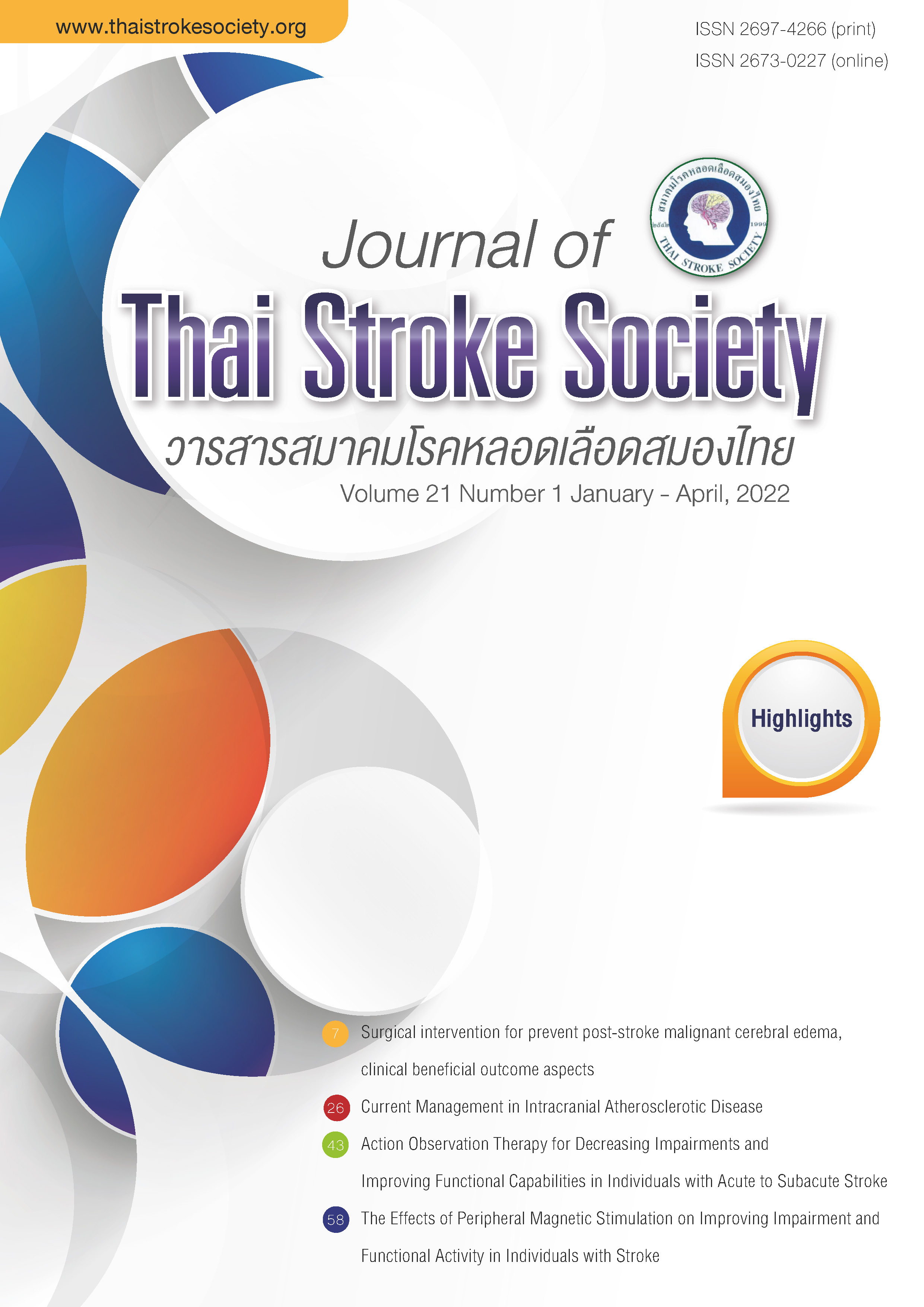The Effects of Peripheral Magnetic Stimulation on Improving Impairment and Functional Activity in Individuals with Stroke
Keywords:
Peripheral magnetic stimulation: PMS, Stroke, Improve, Functional activityAbstract
Peripheral magnetic stimulation (PMS) is one of several novel non-invasive treatment of individuals with stroke, in terms of improving impairments and functional activities
debilitated by brain dysfunction. Studies focusing on the effects of PMS have shown that impairments such as a decrease in muscle tone or muscle guarding have been restored. It has also been shown to be useful in the relieving of pain, increasing in muscle strength and
improving the use of the upper and lower extremities function. In addition, PMS also assists in the promotion of improvement in gait and the activities associated with daily living in individuals with stroke. The purpose of this review was to identify the extent of the impact of the use of PMS in improving impairment and functional activities in individuals with stroke as well as to summarize the findings to date. Whatever the aim of the use of PMS the intensity and type of pulse need to be considered in relation to the needs of the patient status. It also needs to be recognized that the use of PMS is not appropriate in some stroke
patients and the physiotherapist needs to screen all patients before applying this treatment.
References
สมชาย โตวณะบุตร, สุชาติ หาญไชยพิบูลย์กุล ทัศนีย์ ตันติฤทธิศักดิ์, ธเนศ เติมกลิ่นจันทร์, ลินดา เหล่ารัตนใส และจิดาภา ตรัยเจริญวงศ์. โรคหลอดเลือดสมอง (Stroke). ใน: ชุษณะ มะกรสาร. (บรรณาธิการ) การแพทย์ไทย 2554-2557 พิมพ์ครั้งที่ 1. นนทบุรี: กรมการแพทย์ กระทรวงสาธารณสุข;2557.หน้า(4-1)-(4-29)
กองโรคไม่ติดต่อ กรมควบคุมโรค กระทรวงสาธารณสุข. รายงานประจำปีกองโรคไม่ติดต่อปีงบประมาณ พ.ศ. 2563. กรุงเทพมหานคร: สำนักพิมพ์อักษรกราฟฟิคแอนด์ดีไซน์;2564 หน้า 88-90.
ภัทรา วัฒนพันธุ์. การฟื้นฟูสภาพผู้ป่วยโรค หลอดเลือดสมอง และการป้องกันภาวะแทรกซ้อน. North-Eastern Thai journal of neuroscience. 2560;12(1):31-43.
ปรีดา อารยาวิชานนท์. การฟื้นฟูผู้ป่วยโรคหลอดเลือดสมอง. สรรพสิทธิเวชสาร. 2559;37(1):43-58.
Smith M. International Classification of Function, Disability and Health (ICF) World Health Organization, Geneva 2001; 2013;Virginia, USA.
Masahito K, Alvaro PL. Transcranial magnetic stimulation in neurology. Lancet Neurology 2003;2:145-156.
ภารดี เอื้อวิชญาแพทย์, ธวัชชัย กฤษณะประกรกิจ. เครื่องกระตุ้นแม่เหล็กไฟฟ้าผ่านกะโหลก. ศรีนครินทร์เวชสาร. 2552;24(2):148-53.
Momosaki R, Yamada N, Ota E, Abo M. Repetitive peripheral magnetic stimulation for activities of daily living and functional ability in people after stroke. Cochrane Database Syst Rev. 2017;6(6):CD011968.
Struppler A, Havel P, Müller-Barna P. Facilitation of skilled finger movements by repetitive peripheral magnetic stimulation (RPMS) - a new approach in central paresis. NeuroRehabilitation. 2003;18(1):69-82.
Beaulieu LD, Schneider C. Effects of repetitive peripheral magnetic stimulation on normal or impaired motor control: a review. Neurophysiol Clin. 2013;43(4):251-260.
Beaulieu LD, Massé-Alarie H, Brouwer B, Schneider C. Noninvasive neurostimulation in chronic stroke: a double-blind randomized sham-controlled testing of clinical and corticomotor effects. Top Stroke Rehabil. 2015;22(1):8-17.
Gallasch E, Christova M, Kunz A, Rafolt D, Golaszewski S. Modulation of sensorimotor cortex by repetitive peripheral magnetic stimulation. Front Hum Neurosci. 2015;9:407.
Tittu TJ, Ragupathy S, Naveen V, Dhargave P. Effectiveness of repetitive magnetic stimulation in improving upper extremity function in poststroke hemiparesis: A case report. J Soc Indian Physiother. 2020;4(2):97-100
Lavinia G, Andreea GM, Ileana C, and Mihai B. Spastic tone increase reduced using repetitive peripheral magnetic stimulation: pilot study. Int J Social Scienc. 2017;7(1):56-59.
Chen S, Li Y, Shu X, Wang C, Wang H, Ding L, Jia J. Electroencephalography mu rhythm changes and decreased spasticity after repetitive peripheral magnetic stimulation in patients following stroke. Front Neurol. 2020;11:546599.
Beaulieu LD, Schneider C. Repetitive peripheral magnetic stimulation to reduce pain or improve sensorimotor impairments: a literature review on parameters of application and afferents recruitment. Neurophysiol Clin. 2015;45(3):223-237.
Young HL, Ji MS, MD1, Eun HC, Jang WL. Effects of repetitive peripheral magnetic stimulation on patients with acute low back pain: a pilot study. Ann Rehabil Med. 2018;42(2):229-238.
Dragana Z, Krasimira K. Repeptitive peripheral magnetic stimulation as pain management solution in musculoskeletal and neurological disorder – a pilot study. Int J Physiother. 2016;3(6):721-725.
Fujimura K, Kagaya H, Endou C, Ishihara A, Nishigaya K, Muroguchi K, Tanikawa H, Yamada M, Kanada Y, Saitoh E. Effects of repetitive peripheral magnetic stimulation on shoulder subluxations caused by stroke: a preliminary study. Neuromodulation. 2020;23(6):847-851.
Krewer C, Hartl S, Müller F, Koenig E. Effects of repetitive peripheral magnetic stimulation on upper-limb spasticity and impairment in patients with spastic hemiparesis: a randomized, double-blind, sham-controlled study. Arch Phys Med Rehabil. 2014;95(6):1039-1047.
Prouza O, Kouloulas E, Zarkovic D. High intensity electromagnetic field stimulation can reduce spasticity in post-stroke patients. Int J Physio. 2018;5(3):87-91.
Obayashi S, Takahashi R. Repetitive peripheral magnetic stimulation improves severe upper limb paresis in early acute phase stroke survivors. NeuroRehabilitation. 2020;46(4):569-575.
Ruthiraphon P, Sukhumvada T, Wongphaet P. Immediate effect of repetitive peripheral magnetic stimulation in hemiplegic patients with arm paresis: a pilot study. ASEAN J Rehabil Med. 2021;31(1):16-22.
Kinoshita S, Ikeda K, Hama M, Suzuki S, Abo M. Repetitive peripheral magnetic stimulation combined with intensive physical therapy for gait disturbance after hemorrhagic stroke: an open-label case series. Int J Rehabil Res. 2020;43(3):235-239.
Kanjanapanang N, Munakomi S, Chang KV. Peripheral Magnetic Stimulation. 2021. Treasure Island (FL); StatPearls.
Downloads
Published
How to Cite
Issue
Section
License
Copyright (c) 2022 Journal of Thai Stroke Society

This work is licensed under a Creative Commons Attribution-NonCommercial-NoDerivatives 4.0 International License.
ข้อความภายในบทความที่ตีพิมพ์ในวารสารสมาคมโรคหลอดเลือดสมองไทยเล่มนี้ ตลอดจนความรับผิดชอบด้านเนื้อหาและการตรวจร่างบทความเป็นของผู้นิพนธ์ ไม่เกี่ยวข้องกับกองบรรณาธิการแต่อย่างใด การนำเนื้อหา ข้อความหรือข้อคิดเห็นของบทความไปเผยแพร่ ต้องได้รับอนุญาตจากกองบรรณาธิการอย่างเป็นลายลักษณ์อักษร ผลงานที่ได้รับการตีพิมพ์ในวารสารเล่มนี้ถือเป็นลิขสิทธิ์ของวารสาร





